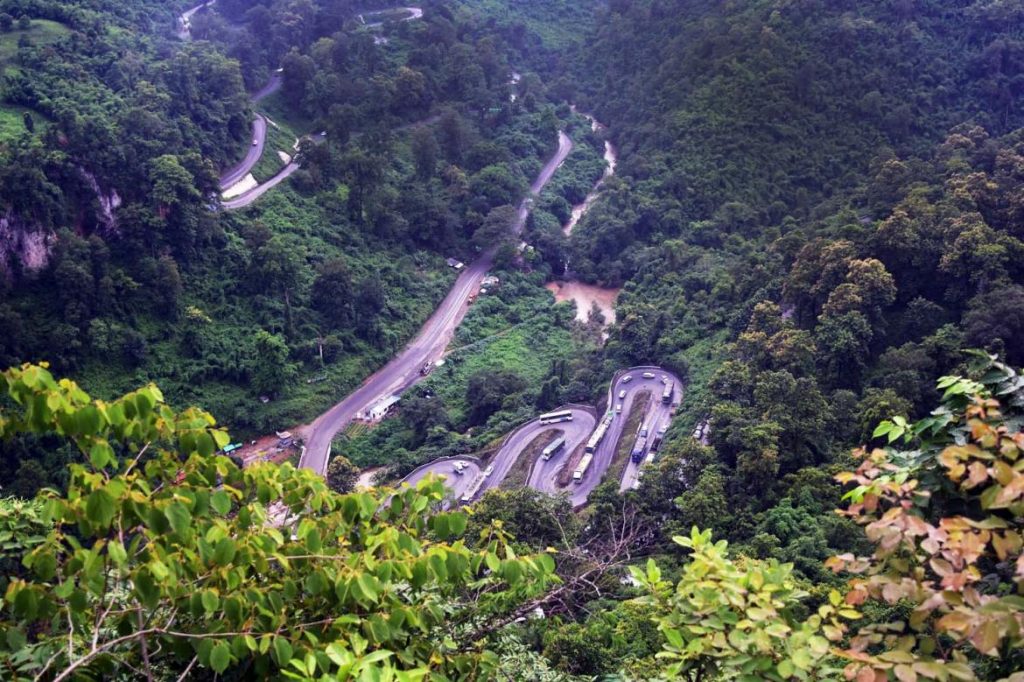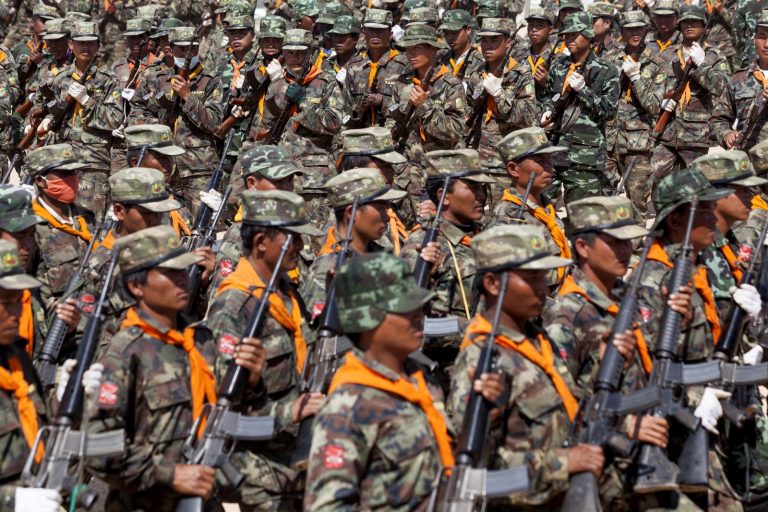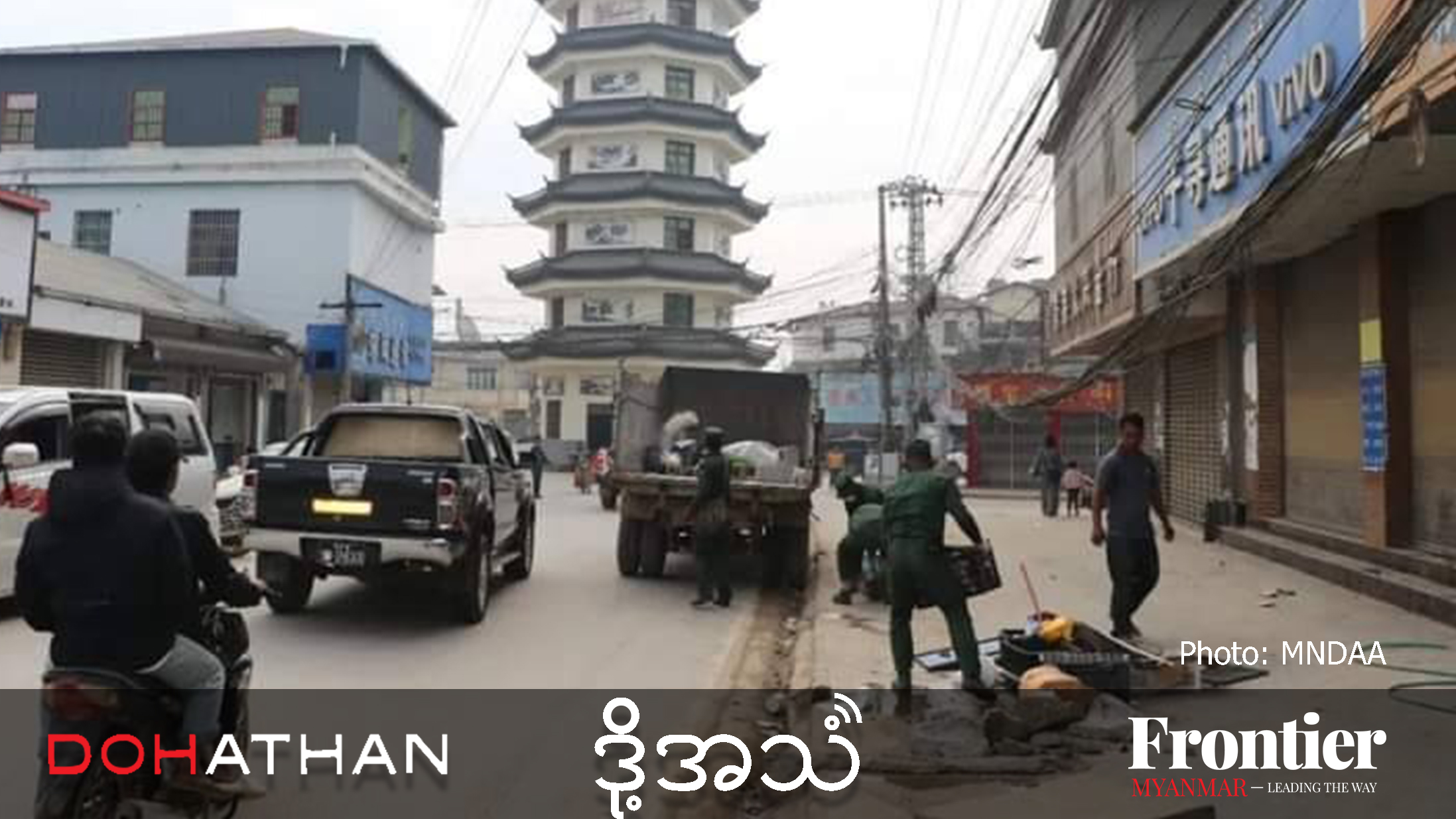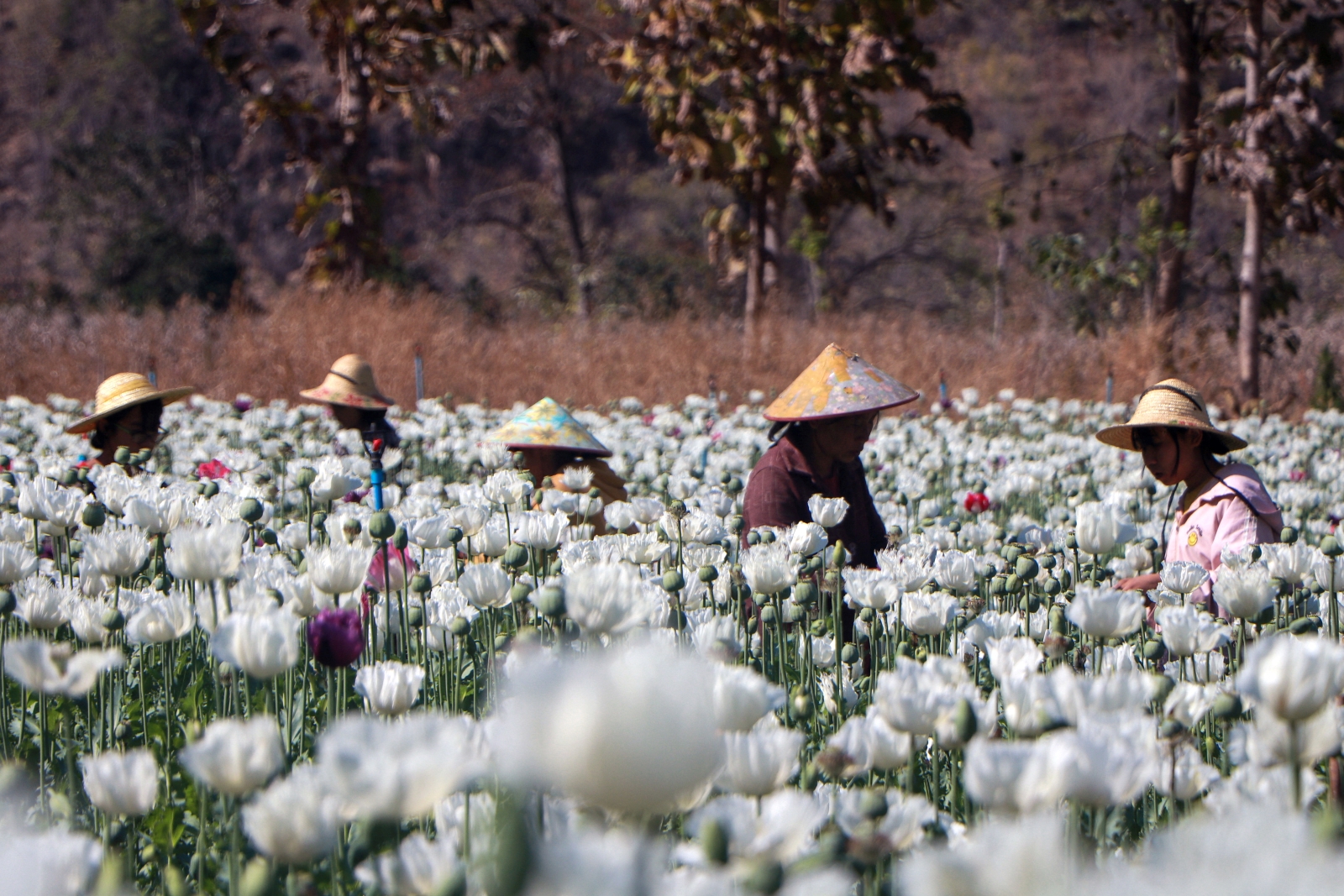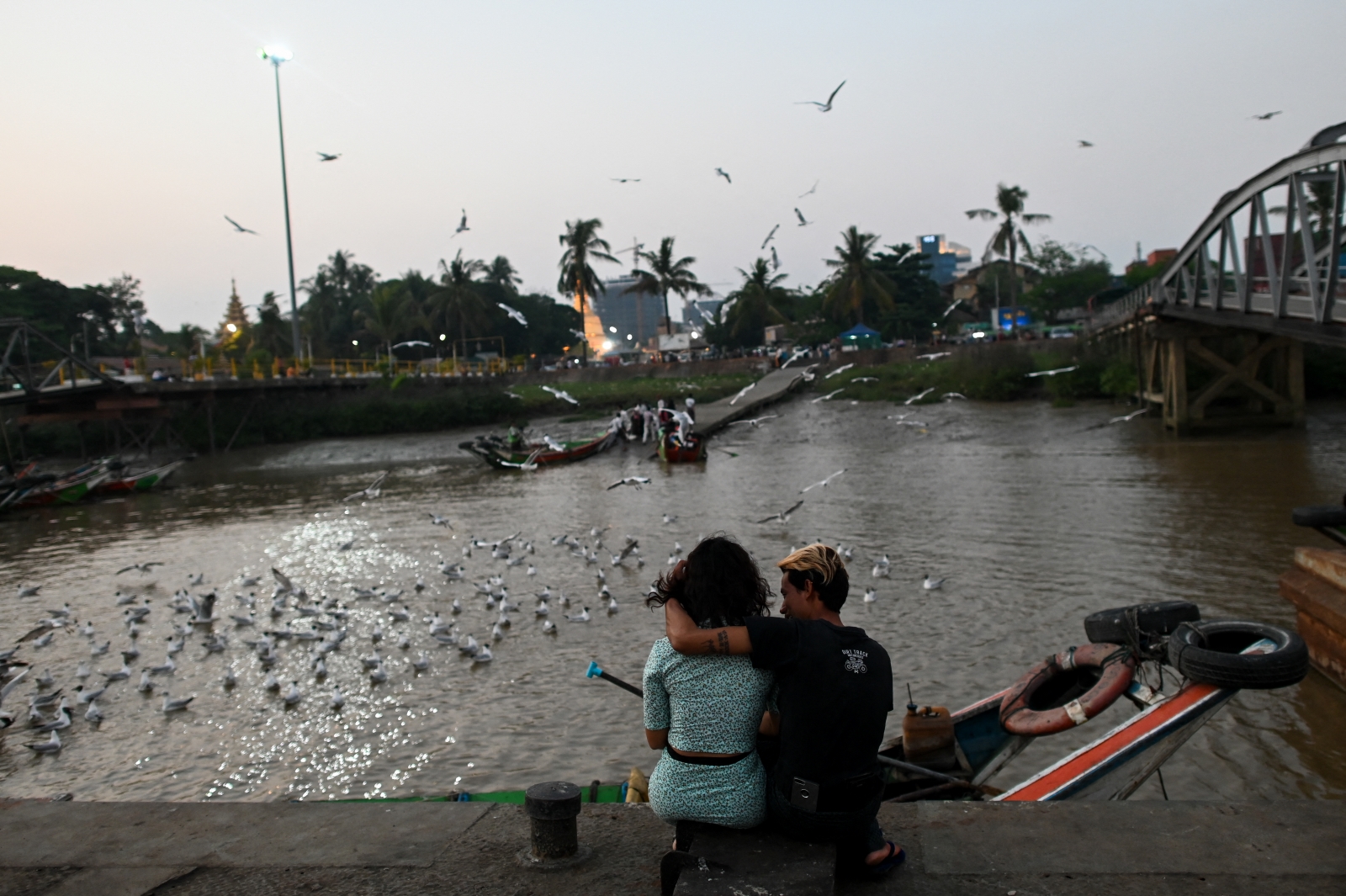Behind closed doors, Myanmar has moved a step closer to approving the ambitious, multi-billion dollar China-Myanmar Economic Corridor.
By CLARE HAMMOND | FRONTIER
AT 10AM ON February 6, then Minister for Planning and Finance U Kyaw Win arrived at the State Guesthouse in Kunming, the capital of China’s Yunnan Province, to meet Mr Ning Jizhe, vice chairperson of China’s National Development and Reform Commission.
Kyaw Win was three days into a visit to China with a delegation of 56 businesspeople from the Union of Myanmar Federation of Chambers of Commerce and Industry, the country’s peak business body.
That morning, he negotiated a draft Memorandum of Understanding for the China-Myanmar Economic Corridor, a wide-reaching initiative that was formally announced by China’s foreign minister Wang Yi in November 2017.
The CMEC agreement is two things. First, it is a physical corridor that would connect China’s landlocked Yunnan through Mandalay to Kyaukphyu and Yangon, on new roads and a high-speed railway, in what Wang called a “three-pillar giant cooperation pattern”.
Support more independent journalism like this. Sign up to be a Frontier member.
Second, it is a conceptual corridor. The overall aim is greater economic integration through initiatives such as industrial zones, trade quotas and tax breaks, but the CMEC can also include cooperation in areas not directly connected to the economy, such as disaster mitigation and public health.
The CMEC agreement is likely to see tens of billions of dollars of investment funnelled into Myanmar from private and state-owned Chinese firms under the One Belt, One Road initiative.
Despite the significance of the agreement for Myanmar’s future, the talks have taken place behind closed doors and with almost no public consultation. State media did not report on Kyaw Win’s trip to Kunming, and details of the February talks were not made public.
The existence of the MoU did not become widely known until four months later, when Myanmar Investment Commission secretary U Aung Naing Oo wrote a short article in the Myanmar Times. The article named some of the priority projects in the corridor for the first time – ambitious greenfield urban developments that would require tens of billions of dollars in investment alone.
Documents obtained by Frontier show that projects put forward by ministries for private sector funding under the CMEC umbrella, and additional projects proposed by the private sector, are worth tens of billions more.
Such a package of investment could transform Myanmar’s economy, potentially creating millions of jobs and facilitating trade with China’s vast consumer market. But it comes with risks. International censure over the Rohingya crisis has put Myanmar in a relatively weak negotiating position. There are fears Myanmar CMEC projects may be a “debt-trap”, while the corridor would also cut through conflict areas.
On September 9, Myanmar and China signed the CMEC MoU. At press time, the contents remained a closely guarded secret.
Interviews with businesspeople and officials involved in discussions that led to the signing reveal a decision-making process that critics say has lacked leadership and transparency.
This is not yet necessarily cause for concern, they said, as the project is still at an early stage. The question now, as further details are ironed out, is whether Myanmar will be able to negotiate a deal that will improve the economy and benefit its people.
A competitive edge
In Muse, Shan State, the largest town on the Myanmar-China border, few are concerned with billion-dollar projects or geopolitics. This is the busiest trade crossing between the two countries; almost 70 percent of Myanmar’s legal overland trade was processed here in fiscal year 2017-18, worth US$5.83 billion.
In the customs yard beyond the town, known as the Muse 105-mile trade zone, U Soe Myint Aung, a deputy director at the commerce ministry, told Frontier there were more urgent problems to be solved. “China has the competitive edge in so many things,” he said from behind a cluttered desk in the compound’s administrative building. “Our trade is not balanced.”
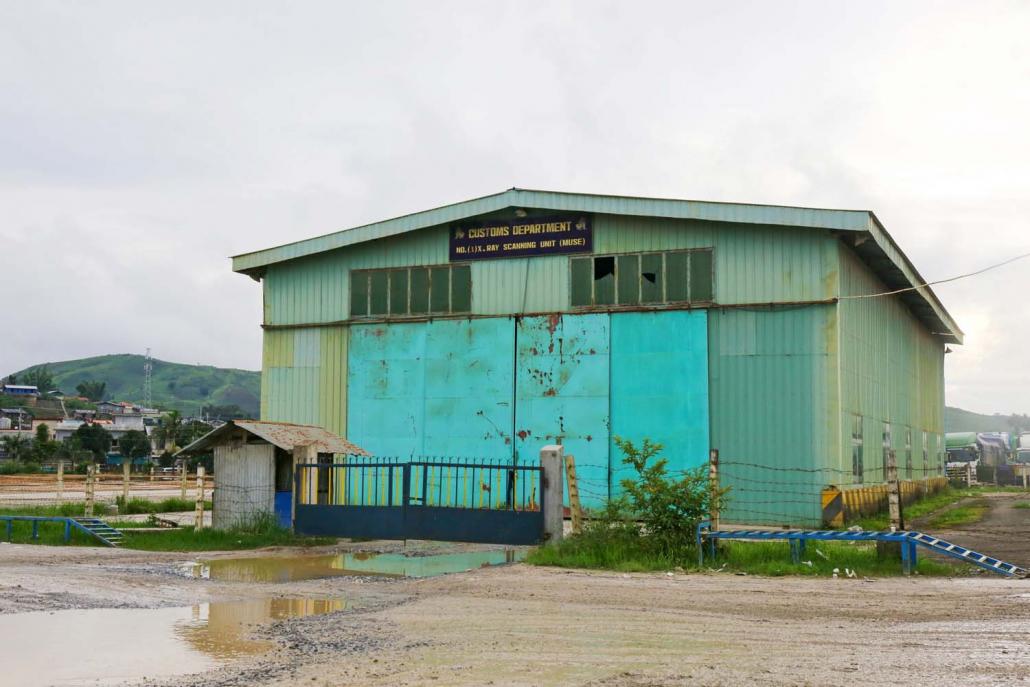
An x-ray scanning unit in the Muse 105-mile trade zone. (Victoria Milko | Frontier)
As an example, he explained that China bans the border trade in rice, sugar and corn. These are three of Myanmar’s largest export earners, so this policy means they leave Myanmar legally but enter China informally. Chinese officials mostly turn a blind eye, but can impose penalties or restrict trade to protect Chinese farmers when necessary.
In a second example, he said Chinese traders refuse to cross the border to do business in Myanmar, so that products from both countries are sold in China.
The imbalance is starkly reflected in the appearance of the border towns: Muse is a dilapidated jumble of warehouses, while Ruili is a modern city of high-rises and markets, including one of the world’s largest for Myanmar jade.
Much of this jade is smuggled across the border and the highway to Muse is a major conduit for illegal trade. But Soe Myint Aung said Chinese officials are not cooperative in cross-border law-enforcement.
“[I believe] they purposefully ignore it. Though they have tight rules, they have so much corruption,” he said. Frontier was unable to reach Chinese officials for comment and the Chinese embassy in Myanmar declined multiple interview requests.
Asked if he thought the CMEC would benefit Myanmar, Soe Myint Aung said Myanmar should be careful. “Since our country is poor, we are vulnerable so we need to take care of things seriously,” he said.
But the investment in infrastructure is also sorely needed. Gesturing outside to trucks parked in a yard, Soe Myint Aung said that for the past five years the Myanmar government had intended to build a separate zone for processing imports near the border. The land has been identified, he said, but there is no budget. Nor is there a budget to build a short road between the two sites.
Infrastructure here is usually funded in one of two ways, he said: by private companies or through donations from China.
Roadblocks
But there is one important infrastructure project underway in Muse. A company called Oriental Highway is widening the two-lane highway that leads to central Myanmar, at a reported cost of US$300 million. Soe Myint Aung says the upgrade is long overdue, because the road is only designed for six-wheeled vehicles but is now used by 22-wheel trucks.
Accidents are frequent and can block traffic for days. When Frontier travelled to Muse from Lashio, the biggest city in northern Shan State, the 174-kilometre (108-mile) journey took 21 hours, because the Kachin Defense Army, a Tatmadaw-aligned militia, was holding a festival beside the road to celebrate the Full Moon of Waso.
Traffic is also sometimes held up by armed conflict. In response to Tatmadaw advances into Shan State, the Northern Alliance of ethnic armed groups has occasionally launched attacks on the Muse 105-mile trade zone and the highway, killing dozens of civilians and some security personnel.
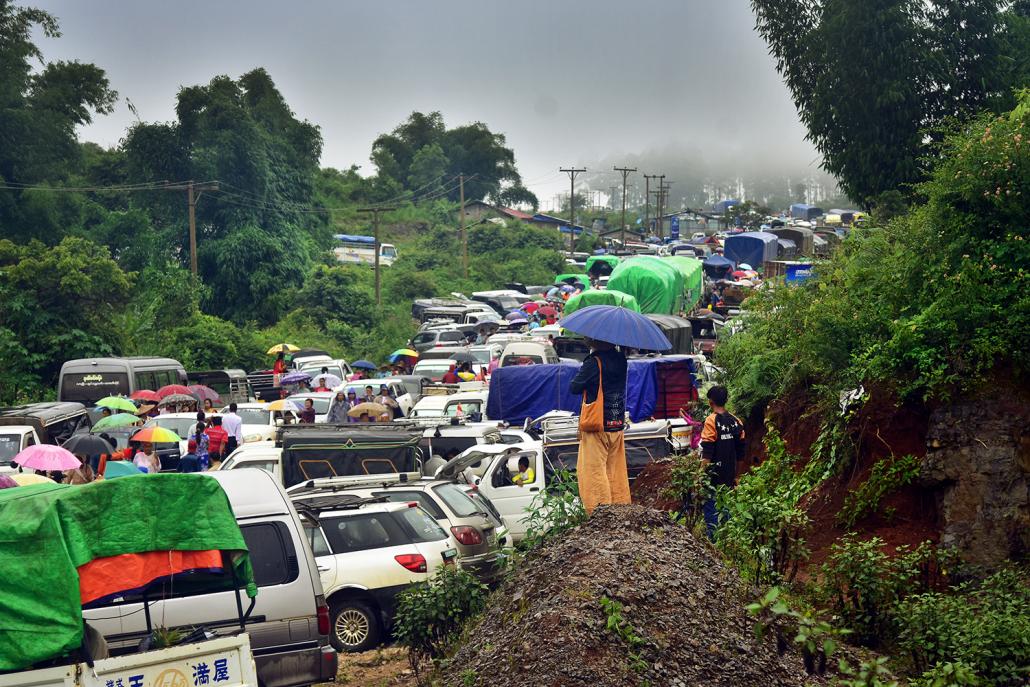
A traffic jam in Shan State’s Kutkai Township, on the highway from Myanmar to China. (Kyaw Lin Htoon | Frontier)
Every armed group in Shan State profits in some way from this trading route, whether through informal taxation or the proceeds of illicit trade. China is the largest market for much of this trade, and local people in Muse and Lashio told Frontier they felt that economic ties with China were already entrenched.
Sai Han, a leader of the Tai Youth Network and a former soldier in the Shan State Army-North, said Chinese businesspeople run the most lucrative industries in Lashio, including the karaoke bars and casinos, with the backing of armed groups and militias.
National reconciliation
Development of an east-west economic corridor was first prioritised by the State Peace and Development Council in the late 1990s. One of the ministers charged with building this corridor was U Aung Min, who became Minister for Railways in 2003 and later led the peace process under President U Thein Sein.
He told Frontier that he was charged with building a railway from the Rakhine State capital of Sittwe, to Kengtung in eastern Shan State, 40 miles from the Chinese border. He said to build the nation the junta tried to remove barriers to national reconciliation, including physical barriers such as mountains and rivers.
It was a formidable task. Myanmar was isolated; the junta lacked capital and modern bridge-building technologies, and had no access to loans or foreign financing.
When Aung Min asked Senior General Than Shwe for more money, he said the junta chief scolded him, telling him that his job as minister was to find solutions, despite the constraints. So he went overseas to plead for old equipment. China, he said, was the most generous donor.
When Beijing offered to build a high-speed railway, Aung Min readily agreed. Plans were drawn up for a line that would run beside twin oil and gas pipelines from Kyaukphyu on Myanmar’s western coast – where China would build a deep-sea port and a Special Economic Zone – to Kunming, the capital of Yunnan.
Aung Min said he believed at the time that the corridor would help to end Myanmar’s civil conflicts.
“China fully backed the idea of turning conflict areas from battlefields to marketplaces – bringing economic development to those areas for mutual benefit as a way of peace-building,” he said.
Equally, Beijing had the capacity to “ramp up support [for ethnic armed actors] … if the relationship between the Myanmar government and China deteriorated”.
It deteriorated sooner than most expected. In September 2011, less than six months after taking office, President U Thein Sein suspended the $3.6 billion China-backed Myitsone Dam in Kachin State. The agreement for the high-speed railway lapsed in 2014 and was not renewed, while negotiations over the Kyaukphyu SEZ and deep-sea port also stalled.
The priority at the time, Aung Min said, was the removal of Western economic sanctions. Meanwhile, as Myanmar courted the United States and Europe, in 2013 Chinese President Xi Jinping formally announced One Belt, One Road.
It was unclear at first what this would mean for Myanmar. Yet throughout this period, Aung Min said he knew Myanmar had no option but to continue dealing with China. The government could not rely on the West to help “if something happened”, he said. “[The West] would come only when Myanmar was in flames.”
Myanmar’s best hope
Negotiations on the CMEC have taken place against a backdrop of Chinese political support for Myanmar over the Rakhine crisis.
On September 4, 2017, China’s special envoy for Asian affairs Mr Sun Guoxiang met Vice President U Myint Swe at the Presidential Palace in Nay Pyi Taw, 10 days after Rohingya militants attacked border police posts in northern Rakhine. Some 700,000 Rohingya subsequently fled to Bangladesh to escape a brutal military campaign of murder, rape and arson that a United Nations Fact-Finding mission said last week could amount to genocide.
In Nay Pyi Taw, Sun condemned the terrorist attacks and told Myint Swe that China supported Myanmar’s efforts to maintain “peace and stability”, according to the Global New Light of Myanmar.
Two months later, foreign minister Wang visited Myanmar, to unveil plans to build the CMEC and also to assure Myanmar of China’s support in helping to “settle the issue” in Rakhine.
China has been Myanmar’s most vocal – and important – supporter in the face of heavy criticism from the international community, providing protection at the UN Security Council. China can use its veto and is likely to block any move to refer Myanmar to the International Criminal Court over the Rohingya crisis.
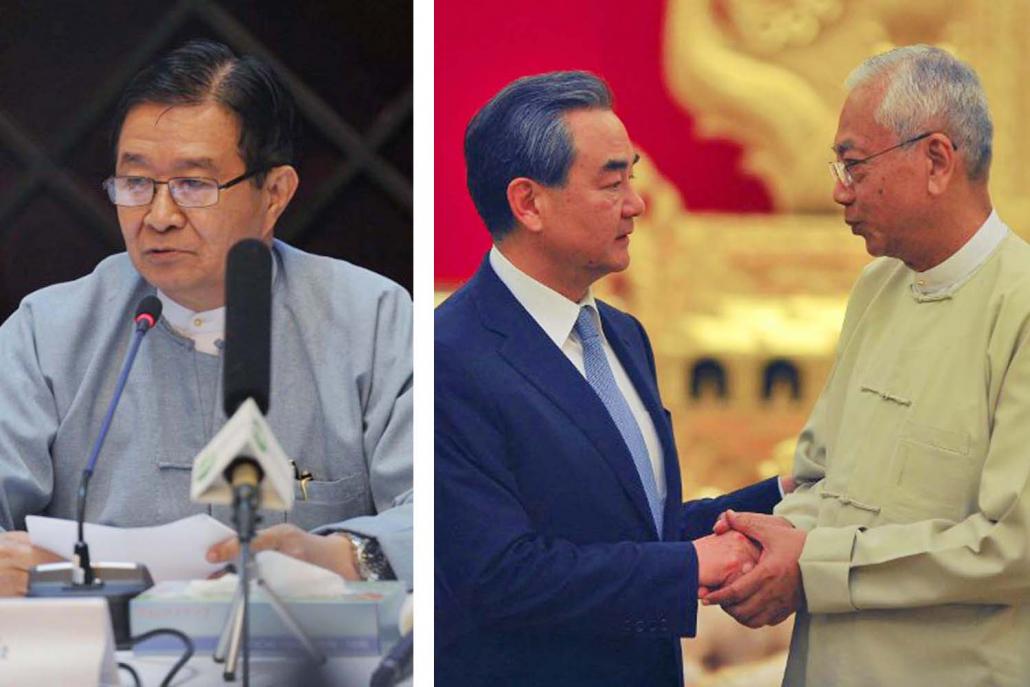
U Aung Min (left), Chinese foreign minister Wang Yi meets then President U Htin Kyaw, in November 2017. (AFP)
While prospects for prosecution seem remote, the Rohingya crisis has deterred Western investment and made Myanmar more dependent economically on China.
All sources interviewed for this article said they believed the CMEC was inevitable and most agreed that it could be important for supporting Myanmar’s economic development.
The most important question, they said, is whether the government can negotiate a beneficial deal.
Troublingly, however, several officials, government advisers and businesspeople told Frontier they were unsure who was leading the negotiations with China. But they agreed on one thing: that the meetings have been held in private and only scraps of information have been made public.
Some hoped this silence around the CMEC means the government wants to limit public debate until key agreements are in place, so as to manage potential fallout arising from anti-Chinese sentiment. Sensitive questions on national security and geopolitical positioning must be thrashed out inside government before the agreement is made public, they said.
But others said the lack of transparency was problematic, particularly as members of industry associations have access to non-public information about the corridor that enables them to influence policy and promote their own business interests.
“We are shaping them”
Negotiations initially appear to have been led by Kyaw Win, who held the twin positions of Minister of Planning and Finance and MIC chair until his resignation in May 2018 amid allegations of corruption.
Formerly a low-ranked civil servant, the minister was widely seen as ill-equipped for his position. Businesspeople say he leaned on the private sector for advice, which he then adopted as policy.
One of the primary mechanisms for the private sector to advise the government has been a fortnightly meeting between the Private Sector Development Committee, a government body formed in October 2016, which is led by Myint Swe, and the UMFCCI.
The UMFCCI ostensibly represents the interests of some 30,000 companies, but the business elite controls its 58-member central executive committee.
The body plays an important role in advancing government policies and is often the first point of contact for foreign investors. Secretary general U Aung Kyi Soe told Frontier that it has become even more influential under the National League for Democracy government.
Aung Kyi Soe said the UMFCCI is regularly asked to accompany the government on overseas trips, so when Kyaw Win went to Kunming to negotiate the CMEC agreement in February it was not unusual that he invited a UMFCCI delegation.
Aung Kyi Soe stressed that businesspeople did not attend government meetings in Kunming, but he said that UMFCCI delegates were able to share their ideas and concerns with the minister.
Asked if the UMFCCI had been advising the government, he laughed and replied: “We are shaping them. UMFCCI are shaping a lot to the government.”
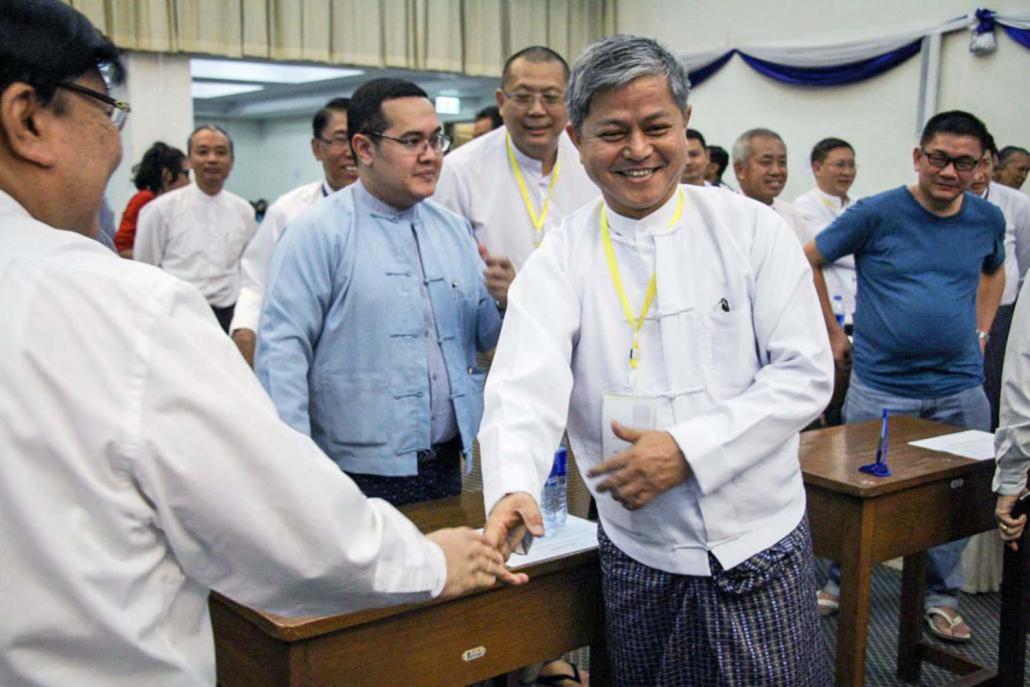
U Aung Kyi Soe is congratulated after being elected UMFCCI secretary general in 2016. (Nyein Su Wai Kyaw Soe | Frontier)
After the draft MoU was agreed, on February 22 the Ministry of Planning and Finance invited UMFCCI representatives to its office, along with permanent secretaries and director generals at government ministries, to begin the process of drawing up a list of “priority projects” for inclusion in the CMEC.
In the private sector, the UMFCCI has become a gatekeeper. Aung Kyi Soe said any company seeking involvement in the corridor must be a member of the federation, and that the UMFCCI is responsible for forming a China-Myanmar Business Council, which would eventually coordinate investment in the CMEC.
The government’s reliance on the UMFCCI and its partner associations has frustrated some businesspeople.
Mr Kiwi Aliwarga, whose conglomerate UMG Group prospered under the former government, said he supported the CMEC initiative but warned that the system of choosing projects created opportunities for cronyism and corruption.
“Only people close to a ministry or a minister can submit [projects] and get funding. The others, no,” he said.
He said the projects proposed by ministries should be vetted to ensure they benefit Myanmar and not just narrow interests, and said there should also be mechanisms for accountability.
“There should be one ministry with responsibility for the entire project, otherwise there will be a lot of waste and the public will have to pay,” he said.
He also took issue with the public-private partnership model, saying it created a conflict of interest. “The government should make sure the rules are followed, not be a player,” he said.
Priority projects
The list of ministry-led and private sector priority projects obtained by Frontier and verified by several sources is a miscellany of disparate projects that appears to validate accusations that Myanmar lacks a strategy for the CMEC.
Some of the projects are small: the Ministry of Agriculture, Livestock and Irrigation, for example, has proposed among other priorities the building of two sluice gates for less than $1 million.
Among projects proposed by the Ministry of Commerce are those that Soe Myint Aung said the government had been unable to fund in Muse: a new zone for processing imports and a road connecting it to the existing 105-mile trade zone.
At the other end of the scale, the list includes industrial parks, new city projects and urban developments, some of which would cost billions of dollars to build, including the five “mega projects” promoted by Aung Naing Oo in Hong Kong.
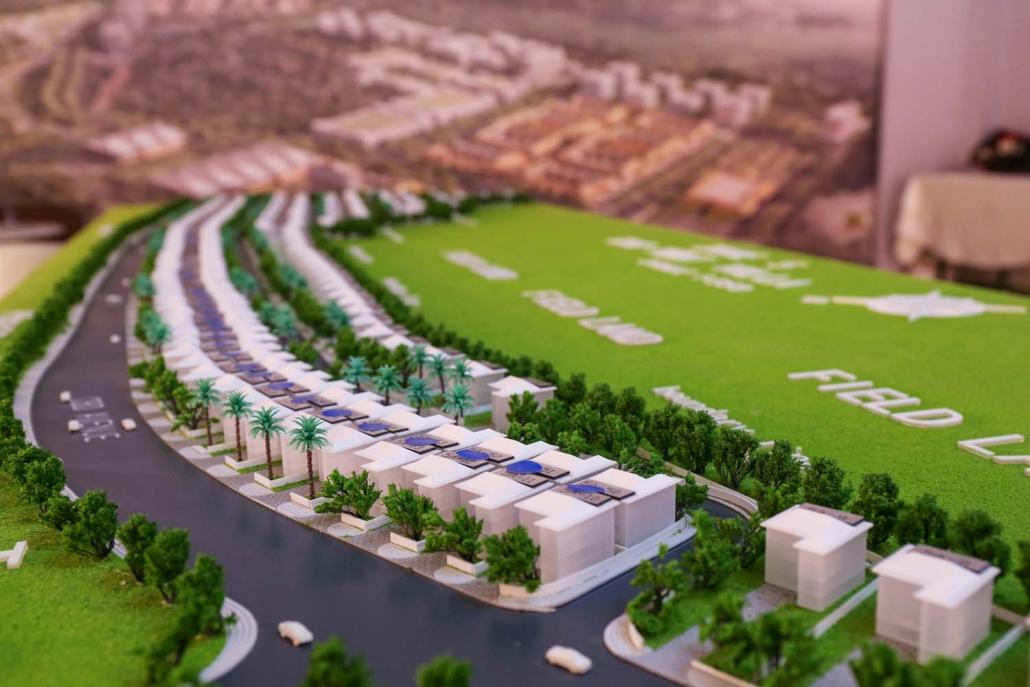
A model of the Muse Central Business District, one of five CMEC “mega projects”. (Victoria Milko | Frontier)
There are aspirational private sector developments on the list too, including a $3 billion Yangon Sky Train, which would be built by China Road and Bridge Corporation and Myanmar conglomerate Jewellery Luck Group of Companies.
A $2.5 billion Yangon Central Railway Station redevelopment, for which a consortium led by Singapore’s Oxley Holdings, with Myanmar’s Min Dhama and China’s Sino Great Wall was selected in February as preferred bidder, is also on the list.
Min Dhama is a subsidiary of Mottama Holdings, which has four projects on the CMEC list, including a $2.18 billion Yangon Outer Circular Expressway and two industrial zones costed at a combined $1.39 billion.
Mottama, which is owned by Chinese-Myanmar entrepreneur U Yang Ho, made headlines in May during the corruption investigation that led to the resignation of minister Kyaw Win, because the minister had worked as a consultant for Mottama until October 2015, a month before the general election in which he won a seat as an NLD lawmaker.
The list of priority projects does not include others being developed by Myanmar and China that fall outside the CMEC framework, including border trades zones at Kampaikti in Kachin State and Muse and Chinshwehaw in Shan State, as well as the SEZ and deep-sea port at Kyaukphyu.
Minister for the Office of the Union Government U Thaung Tun has also said a high-speed railway will now go ahead and several sources confirmed that this would form the backbone of the CMEC.
A 330-kilometre (205-mile) railway, from Dali in Yunnan province to Ruili on the Myanmar border has been under construction since 2011 and is scheduled for completion in 2021. It would connect to a high-speed line between Muse and Kyaukphyu and possibly a spur line from Mandalay to Yangon.
The railway and highways across the Rakhine and Shan mountain ranges would be expensive because the route is technically challenging. An earlier feasibility study for the railway priced the project at $20 billion; Aung Min said Beijing had offered to pay for 90 percent but even then, Myanmar could not afford its share.
Taken together, the costs of all the projects that have now been proposed would dwarf Myanmar’s total external debt, which in fiscal year 2017-18 was $9.6 billion, or 14.5 percent of GDP, according to International Monetary Fund data.
Given the potential size of the projects, careful consideration of the long-term costs and benefits of each project will be essential, historian Dr Thant Myint-U told Frontier. “Public consultation, maximum transparency, and maximum environmental safeguards, will all be crucial,” he said.
Restoring order
Since the NLD government took office, there has been an effort among reformers to create a transparent system for developing infrastructure projects under the Myanmar Sustainable Development Plan, which was published last month.
Deputy finance minister U Set Aung previously told Frontier that under the MSDP a list of priority projects and programs would be drawn up, time-bound and costed. Those that pass a screening process would be included in a project bank.
The MSDP is being developed separately from the CMEC, however. The two frameworks now need to be aligned, said one government adviser.
“If you’re going to go to the trouble of designing programmes that make economic sense and are aligned to the country’s needs, it’s not so good that something comes in that’s totally outside that framework,” he said.
“Scrutiny will be required at every level because clearly this will go on for years, with all sorts of projects rolled out under it,” he continued. “[The CMEC] is a giant branding exercise for a whole bunch of projects that might be desired by actors here, by state enterprises in China or by the Chinese government.”
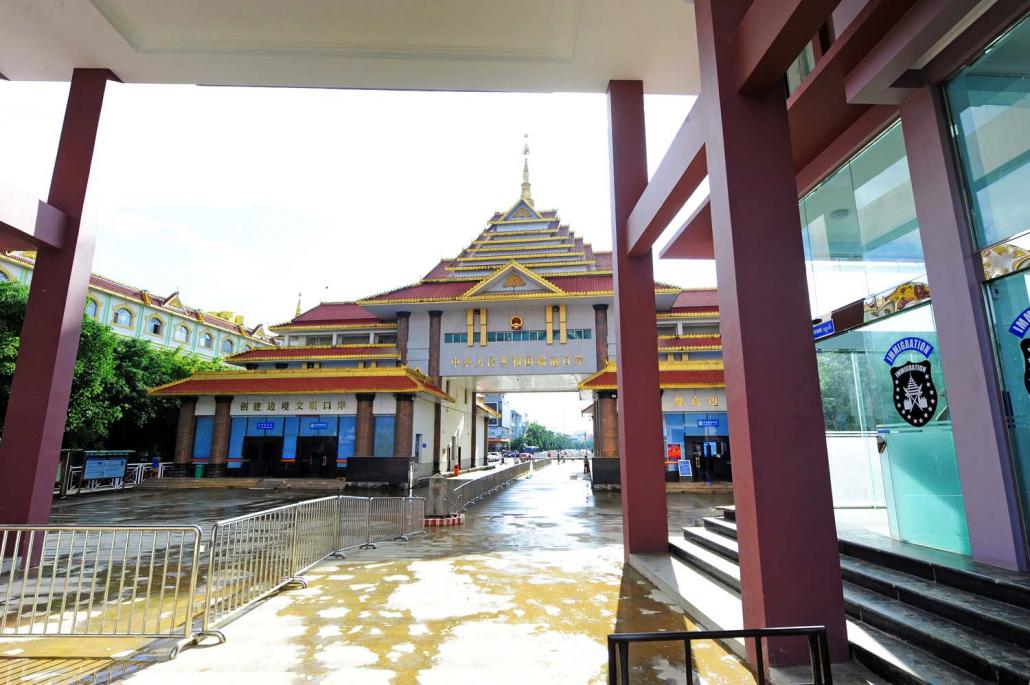
The border crossing between Muse in Shan State and Ruili, in China’s Yunnan.province. (Steve Tickner | Frontier)
In recent months, there appears to have been an effort to improve coordination. In May, Kyaw Win’s resignation opened up two positions. U Soe Win, the respected former head of the Myanmar branch of Deloitte, was appointed finance minister and Thaung Tun became MIC chair.
In July, Set Aung, who has been leading the MSDP process, was appointed joint-chair of the Kyaukphyu SEZ Management Committee with Soe Win.
On August 2, Reuters reported that Myanmar had scaled back the cost of the Kyaukphyu deep-sea port from $7.3 billion to $1.3 billion. Set Aung told the newswire that Myanmar would give no sovereign guarantees for the loans financing the project and would avoid taking on debt.
Those with knowledge of the CMEC MoU signed by Soe Win on September 9 said Myanmar had negotiated to remove some of the projects that were the most concerning in terms of debt, as well as conditions that seemed to give excessive rights to Chinese investors, and that additional safeguards have been inserted.
Both Myanmar and China will now form working groups that focus on 12 different areas, “including development planning, investment, transportation, energy and border economic cooperation zones”, according to the Global Times.
Soe Win is generally trusted to do his best to ensure that the CMEC is in line with Myanmar’s priorities, financially sound and of benefit to both countries. But there was consensus among those who Frontier interviewed that transparency and public debate would be essential components of the project’s success.
At a May seminar on the CMEC hosted by U Thant House and Yunnan University Institute of Myanmar Studies, Thant Myint-U stressed the tremendous impact that big infrastructure projects will have on communities across the country.
“We need to think about how best to discuss and decide on future projects, future schemes, in ways that will nurture and not weaken Myanmar’s still emergent democratic culture,” he said.
His speech also addressed the unprecedented opportunity that Myanmar must now seize.
“Managing relations with China is not only critical, it is a potential game-changer for Myanmar, its winning move on the chessboard, a chance to unlock the answer to other problems,” he said. “Myanmar has to get it right.”
Additional reporting by Kyaw Lin Htoon and Thomas Kean.


